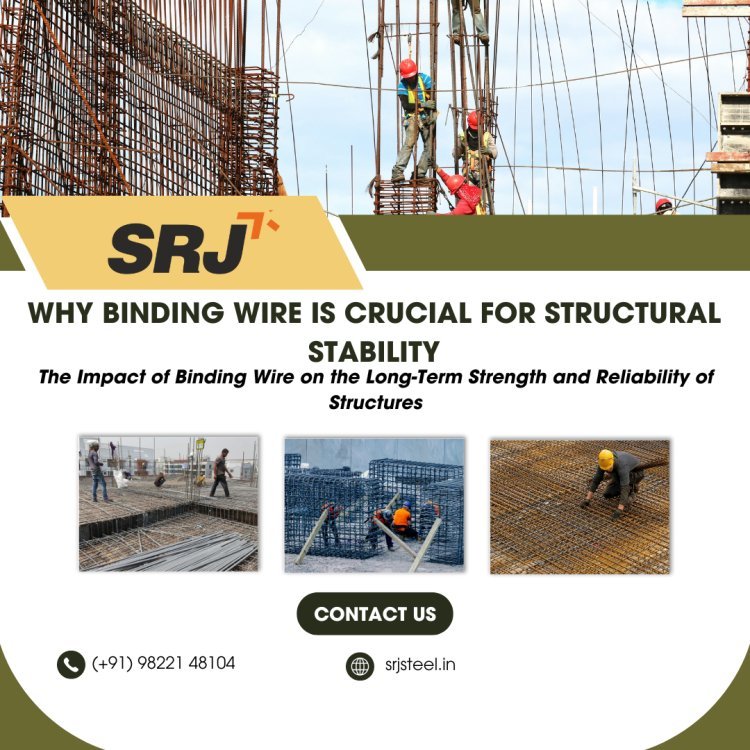Why Binding Wire is Essential for Stability: A Look at Construction Rings and TMT Bars
Binding wire plays a crucial role in maintaining the stability of construction projects, particularly when used with TMT bars and construction rings. It ensures reinforcement elements are securely tied together, preventing displacement and enhancing structural strength. This is essential for achieving safety and durability in building foundations, walls, and frameworks.

Strong structural integrity in construction relies heavily on proper reinforcement techniques. Among the crucial components that ensure this strength, binding wire plays a pivotal role in securing construction elements together. Understanding its significance helps construction professionals make informed decisions about material selection and application methods.
Understanding Binding Wire and Its Role
Binding wire serves as the crucial connector that holds reinforcement components together during concrete construction. This seemingly simple element prevents the displacement of TMT bars and maintains their positioning throughout the concrete pouring process. The wire's flexibility and strength make it indispensable for creating stable structural frameworks.
Construction rings and TMT bars form the skeleton of concrete structures, but binding wire acts as the essential fastener that keeps these elements properly aligned. Without proper binding techniques, even the highest-grade TMT bars could shift during concrete placement, compromising the structure's integrity.
The Technical Aspects of Proper Binding
The effectiveness of binding wire depends on several key factors:
Material Quality
High-quality binding wire exhibits optimal tensile strength and malleability. These properties ensure secure connections between construction rings and other reinforcement components. The wire must maintain its grip under various environmental conditions and construction stresses.
Application Methods
Professional construction teams employ specific binding techniques to secure TMT bars effectively. These methods include figure-eight ties, saddle ties, and cross ties, each serving different purposes in the reinforcement framework. Proper application prevents movement during concrete pouring and curing phases.
Integration with Other Components
Binding wire works in harmony with construction rings to create a stable reinforcement grid. This integration supports the even distribution of structural loads and enhances the building's overall stability. The wire's gauge and type should match the specifications of the TMT bars and construction rings being used.
Factors Affecting Performance and Durability
Several elements influence the long-term effectiveness of binding wire:
Environmental Conditions
The wire must withstand various weather conditions while maintaining its structural integrity. Quality binding wire resists corrosion and degradation, particularly in exposed areas during construction.
Load Requirements
Different construction projects require varying levels of binding strength. The selection of appropriate binding wire gauge depends on the size of TMT bars and the structural load requirements. Heavier construction rings and bars typically need stronger binding wire configurations.
Installation Expertise
Professional installation ensures that binding wire performs its intended function effectively. Proper tension and tying techniques prevent slippage and maintain the precise positioning of construction rings and TMT bars throughout the construction process.
Making Informed Choices
When selecting binding wire for construction projects, consider these crucial factors:
Quality Standards
Choose binding wire that meets or exceeds industry standards for strength and durability. Quality manufacturers provide detailed specifications and testing certificates for their products.
Compatibility
Ensure the selected binding wire complements the dimensions and specifications of the TMT bars and construction rings in use. Proper matching of components enhances overall structural stability.
Cost-Effectiveness
While initial costs matter, focus on the long-term value that quality binding wire provides. Superior products reduce the risk of structural issues and minimize future maintenance requirements.
The Impact on Construction Success
Proper application of binding wire significantly influences construction outcomes:
Structural Integrity
Well-secured TMT bars and construction rings create stronger, more durable structures. Quality binding wire maintains the designed spacing and alignment of reinforcement components.
Construction Efficiency
Using appropriate binding wire speeds up construction processes while ensuring quality results. The right materials and techniques reduce the need for corrections and adjustments during construction.
Safety Assurance
Reliable binding wire connections contribute to workplace safety during construction and long-term structural stability. This essential component helps prevent reinforcement shifting and potential structural weaknesses.
Conclusion
Selecting and properly utilizing binding wire represents a crucial decision in construction projects. Its role in securing TMT bars and construction rings directly affects building stability and longevity. By understanding its importance and choosing quality materials, construction professionals can ensure superior structural outcomes that stand the test of time.
What's Your Reaction?















